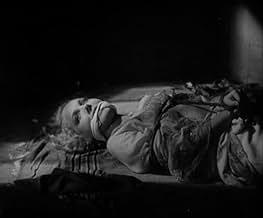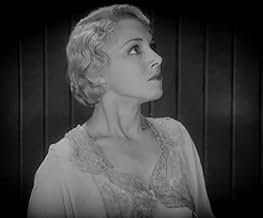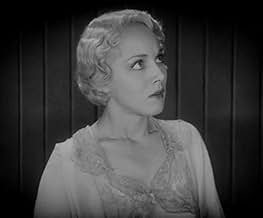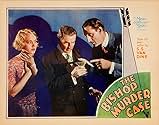Füge eine Handlung in deiner Sprache hinzuWhen the body of a man nicknamed "Cock Robin" is found with an arrow in the heart on an archery range along with a chess bishop as a clue, Philo Vance investigates.When the body of a man nicknamed "Cock Robin" is found with an arrow in the heart on an archery range along with a chess bishop as a clue, Philo Vance investigates.When the body of a man nicknamed "Cock Robin" is found with an arrow in the heart on an archery range along with a chess bishop as a clue, Philo Vance investigates.
- Regie
- Drehbuch
- Hauptbesetzung
Charles Quatermaine
- John Pardee
- (as Charles Quartermaine)
Sidney Bracey
- Pyne
- (as Sydney Bracey)
Richard Cramer
- Detective in Park
- (Nicht genannt)
Frank Fanning
- Officer Manning
- (Nicht genannt)
Marcia Mae Jones
- Hungry Child in Park
- (Nicht genannt)
Broderick O'Farrell
- Dr. Van Pelt
- (Nicht genannt)
Empfohlene Bewertungen
"The Bishop Murder Case" is one of the best in the Philo Vance film series. The mystery seems a bit silly at first when children's nursery rhymes are used by the perpetrator of the crimes to publicize his murders, not unlike methods used by present-day serial killers. But once the plot unfolds the nursery rhyme angle makes complete sense. The Bishop is a key figure in solving the mystery as the title indicates. So keep your eyes focused on that clue. I won't say any more except to add that this is a complex mystery.
Basil Rathbone is second only to William Powell in breathing life into S.S. Van Dine's famous private investigator. It's obvious from this performance why Rathbone was chosen at the end of the decade to play Sherlock Holmes. The other actor who shines in this movie is Roland Young. Though much of the acting hearkens back to the silent era which was coming to an end, Rathbone and Young seem modern in their approach. From playing on stage and in silent pictures, actors were used to wild exaggerations and outlandish gesticulations which were no longer needed now that movies could talk. Several of the characters in "The Bishop Murder Case" have not yet adjusted to working with sound. Not so Rathbone and Young.
Another early talky distraction for modern viewers is the absence of music for dramatic effect. Since live music was used to accentuate the silent screen action and mood, it seems strange that music was not immediately utilized for the same purposes on the talky screen. Producers were misinformed that music coming from nowhere would puzzle and confuse the audience. So it took a few years for Hollywood to rid itself of this misconception. The decision not to use music plus fairly primitive sound effects (the viewer will readily recognize the sound of thunder as the sound of huge sheets of metal being snapped)take away from the overall effects of this otherwise clever and well-written murder mystery.
Basil Rathbone is second only to William Powell in breathing life into S.S. Van Dine's famous private investigator. It's obvious from this performance why Rathbone was chosen at the end of the decade to play Sherlock Holmes. The other actor who shines in this movie is Roland Young. Though much of the acting hearkens back to the silent era which was coming to an end, Rathbone and Young seem modern in their approach. From playing on stage and in silent pictures, actors were used to wild exaggerations and outlandish gesticulations which were no longer needed now that movies could talk. Several of the characters in "The Bishop Murder Case" have not yet adjusted to working with sound. Not so Rathbone and Young.
Another early talky distraction for modern viewers is the absence of music for dramatic effect. Since live music was used to accentuate the silent screen action and mood, it seems strange that music was not immediately utilized for the same purposes on the talky screen. Producers were misinformed that music coming from nowhere would puzzle and confuse the audience. So it took a few years for Hollywood to rid itself of this misconception. The decision not to use music plus fairly primitive sound effects (the viewer will readily recognize the sound of thunder as the sound of huge sheets of metal being snapped)take away from the overall effects of this otherwise clever and well-written murder mystery.
S. S. Van Dine's socialite detective is brought to film for the third time - this time having Basil Rathbone play Philo Vance. While I will not argue with some of the critical assertions that the film is static, stationary, and decidedly creaky, not too mention very far-fetched and predictable, The Bishop Murder Case was made in 1930 when sound was just coming into its own. That is very evident in this film as much of the dialog is hard to hear and comprehend. The stationary microphone was used throughout with director Nick Grinde using lots of expansive scenes with the actors standing around the screened microphone as was the case for sound pictures then. That being said, the film is a pretty decent detective mystery for its time. Rathbone makes an affable Vance. His character is given little depth, however. The mystery, while not entirely and sufficiently explained to me has some things going for it with red herrings involving chess pieces, archery, Ibsen plays, and murders emulating nursery rhymes of a kind. While Grinde directs with the limitations at hand, I did like some of his wide shots. The balcony of the building scene when the professor discovers a man killed by an arrow looked quite impressive, and you can see some wide shots that most definitely mirror German film expressionism of the 1920s with some large, long windows shot in the backdrops of several scenes. All the actors are competent with some real nice character turns by the likes of Charles Quartermaine as a chess expert, George F. Marion as a hunchbacked pseudo-intellectual, James Donlan as a police sergeant(giving the film some of its much needed light moments), and Roland Young, Cosmo Topper himself, turning in a sly, witty performance as a possible suspect. The script is unfortunately riddled with too much ambiguity to make any real sense, but when all is said and done, The Bishop Murder case is mildly entertaining - again making consideration for the time it was made.
Basil Rathbone is a dashing, intense-looking Philo Vance in "The Bishop Murder Case," an early talkie that shows signs of the painful transition from silents. I actually had quite a bit of trouble with the sound. I saw it on television and had difficulty understanding what was being said at times.
The film, nevertheless, is very interesting, if only to see Rathbone, with those amazing eyes of his, in his pre-Sherlock Holmes days. His acting is excellent. It was also delightful to see Roland Young. Leila Hyams plays the professor's niece, and she was quite beautiful and effective. It has a good plot as well.
Parts of this film came off like a stage play, probably because some of the actors were still adjusting to film technique. And the sound was darned strange. In one of the outdoor scenes, the actors sounded as if they were speaking through megaphones. Nevertheless, Philo Vance fans should certainly enjoy it, as will others from a historical perspective.
The film, nevertheless, is very interesting, if only to see Rathbone, with those amazing eyes of his, in his pre-Sherlock Holmes days. His acting is excellent. It was also delightful to see Roland Young. Leila Hyams plays the professor's niece, and she was quite beautiful and effective. It has a good plot as well.
Parts of this film came off like a stage play, probably because some of the actors were still adjusting to film technique. And the sound was darned strange. In one of the outdoor scenes, the actors sounded as if they were speaking through megaphones. Nevertheless, Philo Vance fans should certainly enjoy it, as will others from a historical perspective.
This was the third Philo Vance detective film, and the only one to star Basil Rathbone. William Powell played Vance in the two previous films (1929 and 1930) and the two succeeding ones (1930 and 1933). It is fascinating to see the young Rathbone nine years before he made his first Sherlock Holmes film, 'The Hound of the Baskervilles' (1939). He is very much 'Sherlock before Sherlock'. There are two amazing character actors in this one, George F. Marion and Zelda Sears as the Drukkers, brother and sister. What faces! That was when people looked different, not the same as now when everyone is the same. The director makes the most of them, and they certainly add an eerie dimension to this story. A lot of people get killed in this tale, though of course we do not see the blood and gore because it is only 1930, and it is all we can do to hear the early sound sometimes. Cedric Gibbons as Art Director did some bold sets, with enormously high windows and huge rooms. The film is creaky in many ways, but it is a ripping yarn. Try and figure this one out! This is perhaps the cinema's earliest portrayal of a serial killer, which goes to prove that nothing is new. It is not a whodunnit, it is a whodunn'em.
Basil Rathbone makes a good Philo Vance in this murder mystery involving nursery rhymes. It's a forerunner of his great portrayal of Sherlock Holmes later in his career. He even uses his powers of observation to deduce that the sergeant (James Donlan) wrote a check that afternoon, soon has a date with a woman, etc., much the same way Holmes did, continually astounding Dr. Watson. But the comedy Donlan provides - and he's the only comic relief in the film - is on an infantile level. When he sees Rathbone for the first time, he says "I've solved this case, Mr. Vance. It's a murder." The script is really less than lacking in the humor department. On the other hand, all the other characters do not behave as stupid, and are believable in their roles. I loved the interesting faces and characterizations of George F. Marion and Charles Quartermaine. And there is one lovely photographed scene when Leila Hyams is sitting at a desk with a triple mirror when a sinister hand opens the door. You see her terrified face from four different angles at once, and it's a stunning effect.
This is the type of mystery that is virtually impossible to figure out. You have to go with the flow and watch the events unfold until the end when they are explained. There are lots of red herrings along the way, so I found myself switching from one suspect to another as the probable murderer. It was fun.
This is the type of mystery that is virtually impossible to figure out. You have to go with the flow and watch the events unfold until the end when they are explained. There are lots of red herrings along the way, so I found myself switching from one suspect to another as the probable murderer. It was fun.
Wusstest du schon
- WissenswertesSeveral times Sigurd Arnesson (Roland Young) sarcastically calls Philo Vance (Basil Rathbone) "Sherlock Holmes". Nine years later, Rathbone would take the role of Holmes in Der Hund von Baskerville (1939) (and 14 sequels), and it became his iconic role.
- PatzerWhen Vance and fellow detectives investigate the body of Robin, who has been shot with an arrow, the angle of the arrow changes. Sometimes it's straight up out of the body, other times it's at almost a 45 degree angle.
- Zitate
Philo Vance: [to Heath] Sergeant, you're much too trusting for this deceitful world. If everything happened as easy as that, life would be very simple and very dull.
- VerbindungenFollowed by The Benson Murder Case (1930)
- SoundtracksWaltz of the Flowers
(1891-2) (uncredited)
from "The Nutcracker Suite, Op.71a"
Written by Pyotr Ilyich Tchaikovsky
Played on piano by Basil Rathbone
Top-Auswahl
Melde dich zum Bewerten an und greife auf die Watchlist für personalisierte Empfehlungen zu.
- How long is The Bishop Murder Case?Powered by Alexa
Details
- Erscheinungsdatum
- Herkunftsland
- Sprache
- Auch bekannt als
- Дело об убийстве епископа
- Drehorte
- Grant's Tomb, Riverside Drive, New York City, New York, USA(Vance's car drives past in a second unit shot)
- Produktionsfirma
- Weitere beteiligte Unternehmen bei IMDbPro anzeigen
- Laufzeit1 Stunde 28 Minuten
- Farbe
Zu dieser Seite beitragen
Bearbeitung vorschlagen oder fehlenden Inhalt hinzufügen

Oberste Lücke
By what name was The Bishop Murder Case (1929) officially released in Canada in English?
Antwort


































